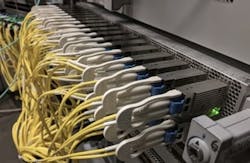NeoPhotonics offers 400G ZR QSFP-DD transceivers with extended case temperatures
NeoPhotonics Corp. (NYSE: NPTN) says it now offers QSFP-DD 400G ZR transceivers with extended case temperature performance up to 80C. The high-temperature capabilities reduce cooling and fan power requirements, according to the company.
Potential users of the 400G ZR optical transceivers include Arista Networks. “The ability of 400G ZR vendors to offer thermally optimized designs capable of supporting higher case temperatures will significantly help reduce system cooling requirements,” said Dr. Hacene Chaouch, distinguished engineer at Arista Networks, via a NeoPhotonics press release. “This is an important consideration for implementing power efficient data center interconnect architectures.”
Arista Networks recently collaborated with Microsoft on a successful demonstration of 400G ZR module interoperability (see “Arista confirms ‘400G ZR’ optical transceiver interoperability with Microsoft"). At the time Arista, through a member of its PR firm, declined to identify the vendors represented in the demonstration, although the PR member said that more than two vendors were involved. Similarly, NeoPhotonics has declined to comment on its potential participation in the event while noting that it has participated in interops in the past (see, for example, "NeoPhotonics, Inphi demo 400ZR optical transceiver interoperability at 120 km").
During a call with financial analysts February 25 to review the company’s fourth quarter and fiscal year 2020 financial results, NeoPhotonics Chairman and CEO Tim Jenks referenced Acacia Communications (now part of Cisco) and Inphi (which is in the process of being purchased by Marvell) as other suppliers of 400G ZR and ZR+ modules (see “Acacia offers range of 400-Gbps coherent optical modules” and “Inphi COLORZ II 400ZR Pluggable Transceiver”).
“We have shipped dozens of units for qualification and we have installed our first production lines for these modules that are now being readied to ramp volumes,” Jenks said of his company’s efforts in this area, according to a call transcript from Seeking Alpha. Later in the call, Wupen Yuen, senior vice president, general manager, and chief product officer at NeoPhotonics, said the company has delivered sample 400ZR QSFP-DD and OSFP transceivers to multiple hyperscale customers, who are using them for testing and qualification. Yuen said he expects the qualification process to complete in the first half of this year, with deployments starting in the year’s second half. He added that deployments and revenues from 400ZR+ modules will begin to ramp in 2022.
For related articles, visit the Optical Technologies Topic Center.
For more information on optical modules and suppliers, visit the Lightwave Buyer’s Guide.
To stay abreast of fiber network deployments, subscribe to Lightwave’s Service Providers and Datacom/Data Center newsletters.
About the Author

Stephen Hardy
Editorial Director and Associate Publisher, Lightwave
Stephen Hardy is editorial director and associate publisher of Lightwave and Broadband Technology Report, part of the Lighting & Technology Group at Endeavor Business Media. Stephen is responsible for establishing and executing editorial strategy across the both brands’ websites, email newsletters, events, and other information products. He has covered the fiber-optics space for more than 20 years, and communications and technology for more than 35 years. During his tenure, Lightwave has received awards from Folio: and the American Society of Business Press Editors (ASBPE) for editorial excellence. Prior to joining Lightwave in 1997, Stephen worked for Telecommunications magazine and the Journal of Electronic Defense.
Stephen has moderated panels at numerous events, including the Optica Executive Forum, ECOC, and SCTE Cable-Tec Expo. He also is program director for the Lightwave Innovation Reviews and the Diamond Technology Reviews.
He has written numerous articles in all aspects of optical communications and fiber-optic networks, including fiber to the home (FTTH), PON, optical components, DWDM, fiber cables, packet optical transport, optical transceivers, lasers, fiber optic testing, and more.
You can connect with Stephen on LinkedIn as well as Twitter.
